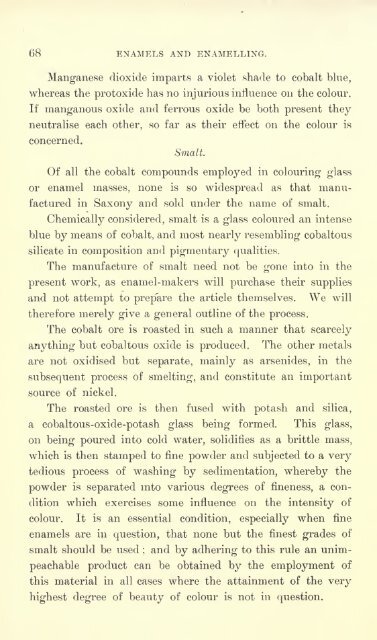Enamels and enamelling; an introduction to the preparation and ...
Enamels and enamelling; an introduction to the preparation and ...
Enamels and enamelling; an introduction to the preparation and ...
You also want an ePaper? Increase the reach of your titles
YUMPU automatically turns print PDFs into web optimized ePapers that Google loves.
68 ENAMELS AND ENAMELLING.<br />
M<strong>an</strong>g<strong>an</strong>ese dioxide imparts a violet shade <strong>to</strong> cobalt blue,<br />
whereas <strong>the</strong> pro<strong>to</strong>xide has no injurious influence on <strong>the</strong> colour.<br />
If m<strong>an</strong>g<strong>an</strong>ous oxide <strong><strong>an</strong>d</strong> ferrous oxide be both present <strong>the</strong>y<br />
neutralise each o<strong>the</strong>r, so far as <strong>the</strong>ir effect on <strong>the</strong> colour is<br />
concerned.<br />
Smalt.<br />
Of all <strong>the</strong> cobalt compounds employed in colouring glass<br />
or enamel masses, none is so widespread as that m<strong>an</strong>u-<br />
factured in Saxony <strong><strong>an</strong>d</strong> sold under <strong>the</strong> name of smalt.<br />
Chemically considered, smalt is a glass coloured <strong>an</strong> intense<br />
blue by me<strong>an</strong>s of cobalt, <strong><strong>an</strong>d</strong> most nearly resembling cobal<strong>to</strong>us<br />
silicate in composition <strong><strong>an</strong>d</strong> pigmentary qualities.<br />
The m<strong>an</strong>ufacture of smalt need not be gone in<strong>to</strong> in <strong>the</strong><br />
present work, as enamel-makers will purchase <strong>the</strong>ir supplies<br />
<strong><strong>an</strong>d</strong> not attempt <strong>to</strong> prepare <strong>the</strong> article <strong>the</strong>mselves. We will<br />
<strong>the</strong>refore merely give a general outline of <strong>the</strong> process.<br />
The cobalt ore is roasted in such a m<strong>an</strong>ner that scarcely<br />
<strong>an</strong>ything but cobal<strong>to</strong>us oxide is produced. The o<strong>the</strong>r metals<br />
are not oxidised but separate, mainly as arsenides,<br />
in <strong>the</strong><br />
subsequent process of smelting, <strong><strong>an</strong>d</strong> constitute <strong>an</strong> import<strong>an</strong>t<br />
source of nickel.<br />
The roasted ore is <strong>the</strong>n fused with potash <strong><strong>an</strong>d</strong> silica,<br />
a cobal<strong>to</strong>us-oxide-potash glass being formed. This glass,<br />
on being poured in<strong>to</strong> cold water, solidifies as a brittle mass,<br />
which is <strong>the</strong>n stamped <strong>to</strong> fine powder <strong><strong>an</strong>d</strong> subjected <strong>to</strong> a very<br />
tedious process of washing by sedimentation, whereby <strong>the</strong><br />
powder is separated in<strong>to</strong> various degrees of fineness, a con-<br />
dition which exercises some influence on <strong>the</strong> intensity of<br />
colour. It is <strong>an</strong> essential condition, especially when fine<br />
enamels are in question, that none but <strong>the</strong> finest grades of<br />
smalt should be used ;<br />
<strong><strong>an</strong>d</strong> by adhering <strong>to</strong> this rule <strong>an</strong> unim-<br />
peachable product c<strong>an</strong> be obtained by <strong>the</strong> employment of<br />
this material in all cases where <strong>the</strong> attainment of <strong>the</strong> very<br />
highest degree of beauty of colour is not in question.
















